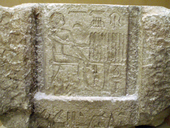- N-water ripple (n hieroglyph)
-
![N35 [n] n](/pictures/enwiki/50/270px-IvoryLabelOfDen-BritishMuseum-August19-08.jpg)
Water Ripple
in hieroglyphsThe ancient Egyptian ripple of water is one of the oldest language hieroglyphs from Ancient Egypt. It is used on a famous cartouche of Pharaoh Den of the First dynasty.
Archaic forms have unique variations, as the later standard usage of the hieroglyph was commonly less important than other hieroglyphs, and was only in the common forms. One 'abbreviated' later form was a straight line with angles on each end. However, the three ripples,
referring to water, or waters became an important hieroglyphic block in itself.

 The alternate n hieroglyph, used for the vertical, is Gardiner, no. S3. the Red Crown.
The alternate n hieroglyph, used for the vertical, is Gardiner, no. S3. the Red Crown.
Contents
Language usage of horizontal "n"
The hieroglyphic language equivalent of the water ripple is n, the letter N, as a phonogram. Its other major use is as a preposition. However as a preposition, it is important because the prepositions are often used interchangeably; its major usage may be for in, to, or by, but from, for, 'because of', through, namely any preposition, or prepositional phrase can quickly be referred to by the common preposition "in", as represented by the water ripple.
Rosetta Stone usage
In the 196 BC Rosetta Stone, the water ripple hieroglyph is used 203 times, averaging 6 times per line, for the 36 lines-(Nubayrah Stele, lines 1-22, Rosetta Stone, 1-14, therefore 36). In the stone as the water ripple, besides the preposition, it is used in names of Arsinoe, and one cartouche form of Ptolemy V Epiphanes, (the Rosetta Stone author). The vertical "N" of the Red Crown is used 35 times in the Nubayrah-Rosetta Stone, mostly prepostional; (only 4 times is it used as a non-preposition). (There are also other variants of the vertical N-Red Crown, with separate Gardiner nos. used in the Rosetta Stone, (as part of Pschent, or a variation on Egypt: "Taui", North and South Egypt, the Two Lands).)
Two important hieroglyphic usages
![S3 [N] N](/pictures/enwiki/54/61px-Canopic_jar_of_Lady_Senebtisi.jpg)
Deshret
or "Red Crown" of the Delta
in hieroglyphs![N35 [n] n](/w/extensions/wikihiero/img/hiero_N35.png)
![N35 [n] n](/w/extensions/wikihiero/img/hiero_N35.png)
![N35 [n] n](/w/extensions/wikihiero/img/hiero_N35.png)
'Waters'
in hieroglyphsIn running hieroglyphic texts that are telling detailed stories, the Ptolemaic Decrees for example, the vertical form of "N" is required as hieroglyphic blocks sometimes end in places not always conducive to ending a block. Two half blocks can be separated, above and below by the horizontal water ripple, or start a block, (on top), or introduce the next block, (by being on the bottom of the block). If room is not sufficient on the bottom, then a vertical form can follow to introduce the next block, thus the use of the vertical N, the red crown of the Pharaoh of the North, the Nile Delta.
Another major usage of the horizontal water ripple-(x 3) is a separate hieroglyph "block", and, with its own ideology, and implied meaning and usage: "waters".
The Egyptian hieroglyph alphabetic letters
The following two tables show the Egyptian uniliteral signs. (24 letters, but multiple use hieroglyphs)
a

i

y


'

(w,u)

B
![D58 [b] b](/w/extensions/wikihiero/img/hiero_D58.png)
P
![Q3 [p] p](/w/extensions/wikihiero/img/hiero_Q3.png)
F
![I9 [f] f](/w/extensions/wikihiero/img/hiero_I9.png)
M

N

R

H1
![O4 [h] h](/w/extensions/wikihiero/img/hiero_O4.png)
H2
![V28 [H] H](/w/extensions/wikihiero/img/hiero_V28.png)
Kh1

Kh2

S

(Sh)=Š

Q/K2

K
![V31 [k] k](/w/extensions/wikihiero/img/hiero_V31.png)
G
![W11 [g] g](/w/extensions/wikihiero/img/hiero_W11.png)
T
![X1 [t] t](/w/extensions/wikihiero/img/hiero_X1.png)
Ch—Tj

D
![D46 [d] d](/w/extensions/wikihiero/img/hiero_D46.png)
Dj

L/(R)
(special)
(Ptolemaic,
etc.)

-- -- -- -- -- a i
(ee)y
ii'
ah, (aïn)w, (u)
(oo)B P F M N R H1 H2 (Kh)1 (Kh)2 S Sh
(Sh)K
emphaticK G T Tj
Ch
TshD Dj (additionally 3
for vert/horiz)-- -- -- -- -- M
(horiz)
M2-PlinthN
(vert)
(see:
N (red crown))S
(vert)
S (folded
cloth)T
(no. 2)
T2-PestleM
(3rd-
-vert)
M3-Baker's tool(additionally 2
for equivalents)-- -- -- -- -- 

(2-reeds)
is—
(2-strokes)
y2-Two strokes
(quail)
is—
(coil)
letter w, u
(see w2-Coil)-
Use of letter "n" in S-n-b, the word for "health", Sen-b, or Seneb. (ripple used 4 times in text)
-
Water ripple used as 'waters' , being used with a Libation vessel
-
The Red Crown of the Nile Delta, in Lower Egypt
See also
References
- Budge. An Egyptian Hieroglyphic Dictionary, E.A.Wallace Budge, (Dover Publications), c 1978, (c 1920), Dover edition, 1978. (In two volumes) (softcover, ISBN 0-486-23615-3)
- Budge. The Rosetta Stone, E.A.Wallace Budge, (Dover Publications), c 1929, Dover edition (unabridged), 1989. (softcover, ISBN 0-486-26163-8)
Categories:- Egyptian hieroglyphs: alphabet-vulture-a-to-cobra-dj
- Egyptian hieroglyphs: sky-earth-water
- Egyptian hieroglyphs-Gardiner listed
-
Wikimedia Foundation. 2010.




